Settling in Hertfordshire
Hertfordshire Archives and Local Studies
After the Empire Windrush arrived in 1948, the passengers gradually dispersed around the country, but no record was kept of who went where. Later on, many newer arrivals made their way to London and the midlands but some made Hertfordshire their home. Throughout the 1950s and 60s, they were settling in large towns such as Watford, and in the north of the county, particularly Hitchin, Stevenage and Letchworth. People were attracted by job opportunities and for those leaving London, New Towns like Stevenage offered better quality housing.
Going to Britain?
An illustrated booklet was issued by the BBC Caribbean Service in 1959 when migration peaked and gave guidance on how to adapt. The authors offer advice on all manner of topics including the difficulties of what to take, finding work, housing, education, trouble with the neighbours, dealing with English landladies, the cold weather, shopping, customs and traditions and the importance of drinking tea. The ‘Private Life’ section dealt with topics such as parties, joining crickets teams, going to church and how to behave in dance halls.
Advice on getting on at work was crucial. Options for women were limited; nursing, factory work, and catering. There would be no jobs for anyone who was uneducated or inexperienced. Men were steered towards skilled trades, such as builders, carpenters, electricans, plumbers and told the importance of night school and trade unions. They were encouranged to bring tools, references and certificates but warned competition was tough and to expect a manual job over a clerical one – and that it could be a long wait. Newcomers were warned of predjudices and to keep smiling, even when being insulted. Socially at work they were encouraged to ‘fit in’, talk about football and cricket and if they had to swear, to use English words.
Where did people live?
Some people arriving directly from the Caribbean in the 1950s and 60s stayed at hostels in Baldock and Letchworth while they looked for work and permanent housing, often for a year before they could move on. It wasn’t always easy to find a job and people could spend every day trudging from factory to factory looking for work. They could also go to the labour exchange in Station Road, Letchworth to register and look for work.
The most widely used term for the new immigrants at the time was ‘West Indian’ , or sometimes ‘coloured’. (‘Black British’ did not come into widespread use until the second generation were born to these post-war migrants to the UK).
In 1965 and 1969, Hertfordshire Constabulary Race Relations reports listed the numbers of ‘coloured immigrants’ by area, and whether the police had any contact with the immigrants, what clubs or societies were provided and the level of integration. The report of 1969 concluded that there were generally, no problems caused by increasing numbers of immigrants:-
Hertford Division
‘The coloured immigrants have not been the cause of any particular trouble in the area. Police officers some into contact with coloured persons in the normal course of their duty. In Hertford there is an International club to which many coloured people belong. This club embraces all types of persons who are strangers to the county, whether they are coloured or European and is responsible for organising social events for its members. In October 1968 a social was held at the Police Sports and Social Club in conjunction with Hertford Rotary Club, which was attended by many coloured people. As a result, good relations were established between officers and those who attended’.
Hertford Sub Division – ‘There are no sizeable groups of coloured immigrants living in the area, although a number of coloured nurses are in accommodation at Hertford County Hospital’.
Bishop’s Stortford Sub Division – ‘The only coloured people living and employed in Bishop’s Stortford are at the Herts and Essex Hospital and at The Rye Street Hospital. The hospital employs approximately 20 doctors on their staff or Indian and Pakistani origin. They also employ 75 nurses, mainly of Malay or West Indian extraction’.
Ware Sub Division – ‘There are no coloured communities within the Ware Division. The entire coloured population comprises of two small families, one of which has been in Ware since before the War and a small number of approximately 4-5 nursing staff at Ware Park Hospital.’
Hoddesdon Sub Division – ‘There are only a handful of coloured persons, not exceeding 12 in Hoddesdon.’
St Albans Sub Division – ‘It is only possibe to make a very liberal approximation of the number of coloured immigrants in the St Albans area. This number is put at 1,100 and is composed of Indian, Pakistani, West Indian and a few Chinese. West Indian people live mainly in the Alma Road, Prospect Road, Inkerman Road, Ramsury Road, Russell Avenue, Ridgmont Road and Gravnville Road area of the town.’
Harpenden Sub Division – ‘There are no more than fifty adult coloured persons residing in this sub division. This is a liberal estimate. There are two to three families residing in the Batford area, and a family in the village of Redbourn. We also have a number of students at the Rothamsted Institute of Agriculture. In addition to these, we have approximately another 60 coloured persons employed in factories on the Coldharbour Industrial Estate, Batford, the majority living in Luton. These are mainly Pakistanis and West Indians, whereas those residing here are mixed, comprising Indian, Pakistanis, Africans, Malays and other emergent nations whose students are studying here for 3 -4 years.’
London Colney – ‘Within London Colney Section there are about 75 coloured families and all are West Indian. They are not settled in any one area but are distributed among the white residents.’
Hitchin – ‘I would consider the total polulation of colured people to be in the region of 4-5,000. There are no coloured populations in the extensive rural areas. There is one coloured traffic warden (Jamaican) at Hitchin who attends the Immigrants Advisory Committee, and has no real problems with her duties, other than the usual traffic warden abuse. One Barbadian has been prosecuted for obscene language to her in the course of her duties.’
Letchworth – ‘306 west Indians; Baldock, 63 west Indians’
Royston – ‘No record is kept but the total number of coloured persons resident in the town is 6.’
Settling down
Those arriving in North Herts in the 1950s and 60s found work in the industrial estates around Letchworth and Stevenage, with companies such as ICL, K & L Foundries, The Letchworth Bacon Factory, Armco and Borg-Warner. Many people met their future husbands and wives through work and went on to get married and start families. They joined unions and social clubs attached to their workplaces and became members of sports clubs. The Stevenage West Indies Sports and Social Club formed a social hub for the surrounding African Caribbean community there.
People who settled in Stevenage from the 1950s to 70s recall both good and bad experiences in Yesterday Today Tomorrow: a Documentary tracing the historical settlement of African Caribbean elders in Stevenage, (by Mark Straker, 2002). Tensions between residents of the old and new towns already existed – Caribbean people were not only looked different, but were ‘new towners’ as well. A house with three bedrooms and a garage in the new town could cost the same as a shared flat in London and many came from Islington and Haringey. Not everyone enjoyed decent housing and help from the local authtority was hard to obtain. This meant that some couples and young families had to live in one room together, sharing a bathroom and kitchen, and it was the same for other ethnic minorities. One said ‘we didn’t have any problems, any racial tension. There weren’t many of us and most of our friends were white. There are lots of mixed herritage familes here now’. Although they faced some predjudice, mixed race families created new communities in which those from different backgrounds swapped cultural traditions.
Looking for work
Finding work wasn’t easy and people regularly suffered discrimination. Men tended to get jobs in factories and women joined the nursing profession, at general hospitals and in the large mental institutions around Watford and St Albans. From 1960 to 1963, women from the caribbean were specifically invited by the British government to train as nurses, midwives take and other care jobs to help staff the National Health Service.
Pioneers
Professor Nola Ishmael OBE, arrived from Barbados in 1963 as a NHS trainee nurse and recalls: ‘At first I had been placed on the Isle of Wight, but I’d said: Why would I go from one small island to another small island? I wanted to broaden my horizons. So I was offered Bishop’s Stortford in Hertfordshire, and after a train journey from Liverpool Street, I was finally at my new home. The Home Sister met us, and I tell you, I have never had a better cup of tea since – so restorative!’ (Keep The Faith)
She went on to become the first Black Director of Nursing in London and in 2000 was awarded an OBE for services to nursing.
‘….without staff from abroad we would be suffering an even more dire shortage of medical staff.’ But for the considerable help of West Indian nurses, the accident hospital would be very hard put to provide a reasonable service. (Birmingham Daily Post 7 October 1961)
Community organisations such as the Watford Afro Carribean Society were set up in the mid 1970s and by 1980, it was estimated that 1,000 people of African Caribbean origin were living in Watford, out of a population of 74,000, with smaller groups in other large towns. The younger generation who were the children of those first migrants needed their own identity, clubs and social events.




















Add your comment about this page
Living in Cannon Street, I knew so many of the early West Indian arrivals to St Albans. Many from the British West Indies, St Vincent, St Christopher, ( St Kitts) St Barts, Nevis, St Lucia. . Still know their grandchildren after all these years! A great addition to St Albans. We also had many Italian families moving in too. They, with the West Indians, worked in the local Hospitals, British Rail, Local Factories ( we had manufacturing then!), the Buses. All good well remembered friends